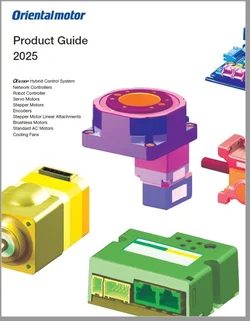According to the Food and Agriculture Organization (FAO) of the United Nations, global food prices reached an all-time high in 2022. This case study explains how a vegetable farm in Hokkaido, Japan, improved production efficiency and reduced costs by building in-house automation.
First, why farm in Hokkaido?
| FYI: Agriculture in Hokkaido |
|
Hokkaidō (literally means " "Northern Sea Circuit") has nearly one-fourth of Japan's total arable land. It ranks first in the nation in the production of a host of agricultural products, including wheat, soybeans, potatoes, sugar beets, onions, pumpkins, corn, raw milk, and beef. (Source: Wikipedia) |
The entire group, which operates all over Japan, develops facilities and equipment and has also started cultivating vegetables hydroponically. For example, the company owns a solar-powered greenhouse of about 355,000 square feet.
We interviewed the president of the company about the equipment that uses Oriental Motor's products, as well as the background of the company's efforts to "automate agriculture".
Behind the Scenes
"Automation of work was essential."
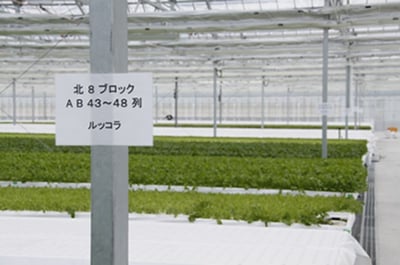 |
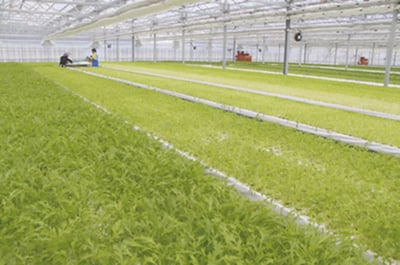 |
By hydroponics method, over 30 types of vegetables, including baby leaves, are produced and shipped all year round.
Please tell us how your company navigated the challenge of entering the agriculture business.
"Attention has been focused on the automation and efficiency improvement that is being carried out in the Netherlands, which is an advanced country in agriculture and institutional horticulture, and companies that have been working on it since around 2006 have become popular in Japan. We decided to focus not only on the building of the greenhouse but also on the system creation and cultivation of internal facilities, and our company was established as an agricultural production corporation."
Smart agriculture and agricultural automation are commonly featured in the media every day. Is the number of inquiries actually increasing?
"Recently, the number of tours and inspections has increased considerably. There are 2 cases a week, and 4 cases at most. People in charge of agricultural businesses and large companies who are thinking of entering agriculture from different industries often visit. Facility horticulture systems developed in collaboration with our parent company, such as hydroponics and air conditioning, are in demand. The new equipment has a touch panel, which enables remote control with a personal computer."
Were you active in automating your operations from the beginning?
"In order to obtain profitability, it was necessary to stably carry out large-scale agricultural production. When I first started working in 2007, I had 4 to 5 employees, including myself, so I was always thinking about how to improve production efficiency with a small number of people. The house produces and ships 12 to 24 vegetables a year, depending on the type of vegetables. To that end, automation of work was essential."
Motor Applications
"I can't go back to the time before the machine was introduced."
| Application 1 | Mobile planter beds for hydroponics culture |
| Type of motor | World K Series single-phase AC gear motors |
| Characteristics | Constant speed, easy wiring, ingress protection |
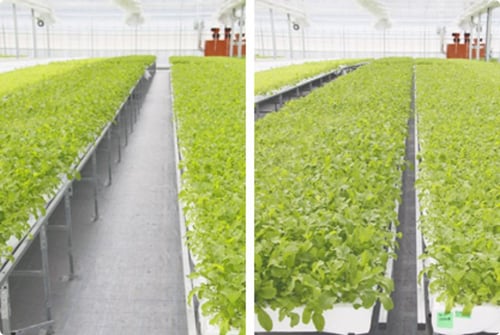 Motors move these beds over 30 meters to secure work aisles. It makes work easier for the operators because there are no obstacles under their feet.
Motors move these beds over 30 meters to secure work aisles. It makes work easier for the operators because there are no obstacles under their feet.
The beds are mobile to ensure work space between the hydroponic planter beds. The purpose is to maximize the cultivation area.
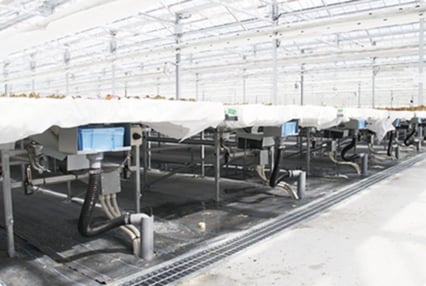 |
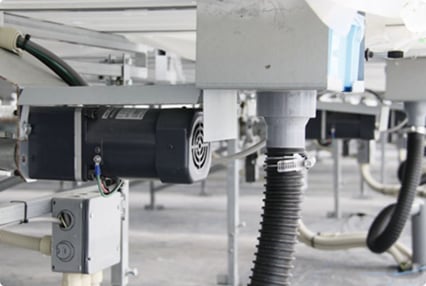 |
| Mobile planter beds are lined up in the greenhouse. | The beds can be driven to the right or left with AC motors. |
How does the device work?
The AC motor allows the bed to move left and right. A bed over 30 meters is driven by a single motor. In the past, we used rollers to move the beds, but since this method requires laying rails on the ground, we had 3 main issues with doing this manually:
- it was difficult to avoid tripping on the rails
- it was difficult to run the work cart
- it was difficult to install a large number of rails horizontally
In the case of the roller, I thought that it was an advantage that the left and right operating ranges were free, but in fact, I came to the conclusion that it was not necessary to move so much, so I reviewed the design and made improvements. We felt that it was sufficient if there is just enough space for people and work carts to pass through.
| Application 2 | Automatic sieving wheel for removing debris |
| Type of motor | BMU Series brushless gear motor & dedicated driver |
| Characteristics | Accurate speed regulation, easy setup, ingress protection |
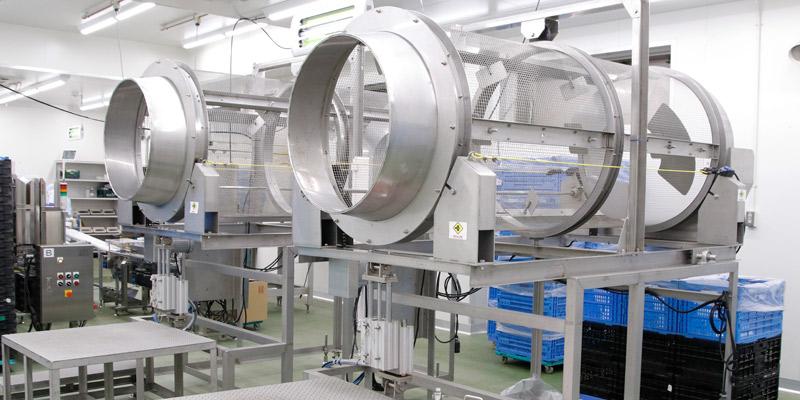
Brushless motors are used for the tumber to mixing multiple types of leaves.
The purpose of this machine is to remove roots and debris adhering to harvested baby leaves, and a brushless motor is combined with a chain sprocket to rotate a large metal sieve basket. Prior to the introduction of this machine, it had to be done manually. Also, when mixing multiple leaves, it was a process of spreading them on a large desk and stirring them manually. Both of these tasks were hard work, so employees often said, "I can't go back to the time before the machine was introduced."
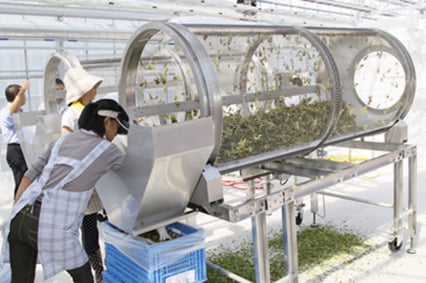 |
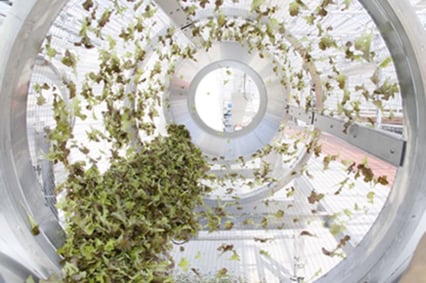 |
|
A large sieving wheel is rotated to remove roots, dirt, and dust. |
The machine is also used for mixing multiple types of leaves. |
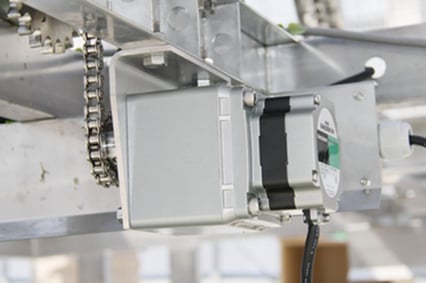 |
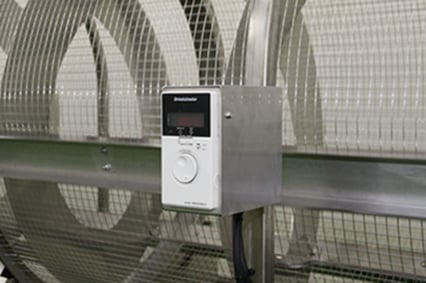 |
| The sieving wheel is connected to the motor by a chain and sprocket. It is driven by a single brushless gear motor that is both dust and drip-proof. |
The motor driver can easily operate the machine and change the speed. |
How does the device work?
The dustproof and watertight brushless gearmotor rotates the large sieving wheel with a chain and sprocket system. An easy-to-use "push-set" driver controls the speed of the motor.
- The compact gearmotors helped minimize the footprint.
- The high IP rating helped protect the motors from periodic washdown.
Please watch this video to see how the motors work in these applications. Sorry English subtitles are not available.
The OM Experience
"Reasonable and reliable delivery times were the first attraction."
Why did you choose Oriental Motor?
"I used to buy AC motors from other companies, but I was inflexible in terms of delivery time, and I was often in trouble because delivery dates weren't reliable. In such cases, Oriental Motor came to mind. Although it depends on the number of units, reasonable and reliable delivery times were the first attraction. I've heard the company name several times before, so it gave me a sense of security. In my research, the after-sales service was excellent, so I chose OM."
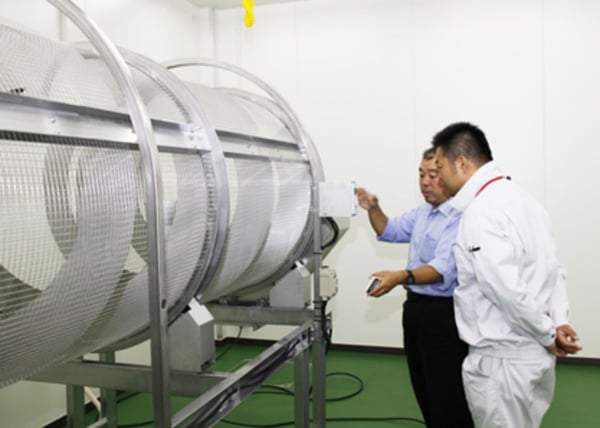
SEs are motion experts and can provide motion control advice.
How was the after-sales communication and support?
"Not only is the after-sales service free, but the support is also timely. Their sales engineers are knowledgeable and will work with us from the initial design stage, making it easy to apply Oriental Motor's products comprehensively. For a small team of engineers, we are very grateful for the support. Even if we're working with a major manufacturer, it is often difficult for us to get the support we need right away."
Looking Into the Future
"Keep improving our automation."
What are your future plans for automation?
"I want to improve and automate the leaf reaper. Employees are reaping now, but at one location, for example, there are 144 hydroponic beds, so operators have to do that all day long. Since we aim to enable anyone to launch a profitable agricultural business in a short period of time, we think we will keep improving our automation."
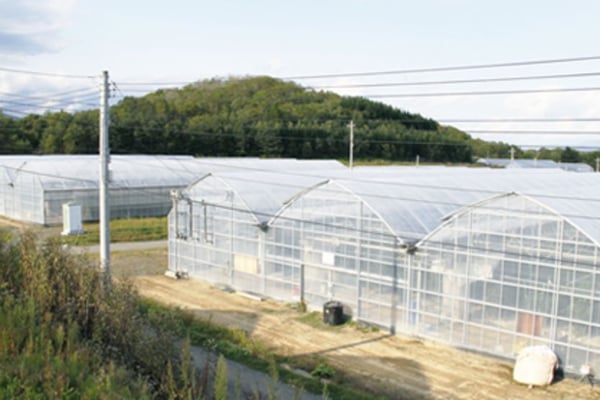
Agricultural automation for greenhouses
In the field of agricultural automation, numerous moving components can be driven by motors, such as AMRs, harvesters, sieving machines, sowing, and even automated windows and doors. Since production efficiency requires minimization of downtime, products with long life, high performance, and high ingress protection will help ensure cleaniness, uptime and profitability.
Recommended Products
Contact our team to see how OM can help!







